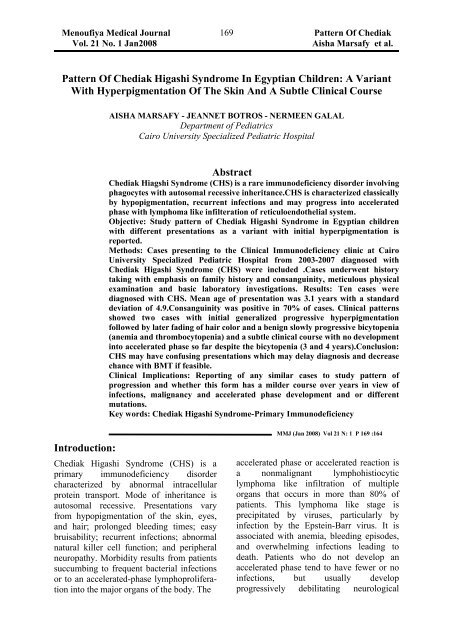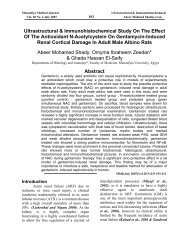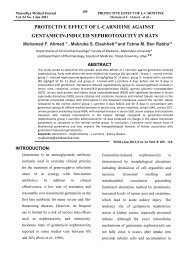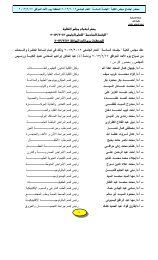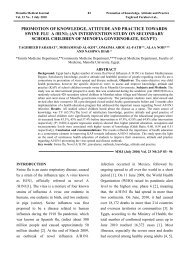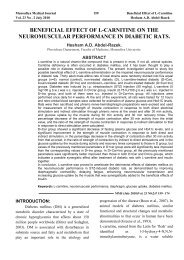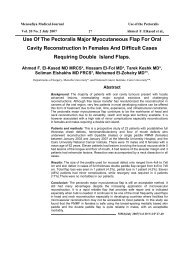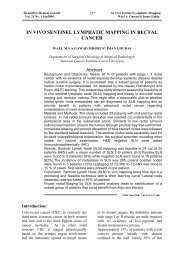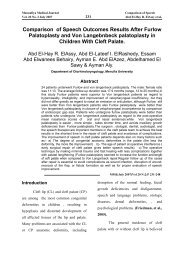Pattern Of Chediak Higashi Syndrome In Egyptian Children
Pattern Of Chediak Higashi Syndrome In Egyptian Children
Pattern Of Chediak Higashi Syndrome In Egyptian Children
You also want an ePaper? Increase the reach of your titles
YUMPU automatically turns print PDFs into web optimized ePapers that Google loves.
Menoufiya Medical Journal<br />
Vol. 21 No. 1 Jan2008<br />
169<br />
<strong>Pattern</strong> <strong>Of</strong> <strong>Chediak</strong><br />
Aisha Marsafy et al.<br />
<strong>Pattern</strong> <strong>Of</strong> <strong>Chediak</strong> <strong>Higashi</strong> <strong>Syndrome</strong> <strong>In</strong> <strong>Egyptian</strong> <strong>Children</strong>: A Variant<br />
With Hyperpigmentation <strong>Of</strong> The Skin And A Subtle Clinical Course<br />
AISHA MARSAFY - JEANNET BOTROS - NERMEEN GALAL<br />
Department of Pediatrics<br />
Cairo University Specialized Pediatric Hospital<br />
Abstract<br />
<strong>Chediak</strong> Hiagshi <strong>Syndrome</strong> (CHS) is a rare immunodeficiency disorder involving<br />
phagocytes with autosomal recessive inheritance.CHS is characterized classically<br />
by hypopigmentation, recurrent infections and may progress into accelerated<br />
phase with lymphoma like infilteration of reticuloendothelial system.<br />
Objective: Study pattern of <strong>Chediak</strong> <strong>Higashi</strong> <strong>Syndrome</strong> in <strong>Egyptian</strong> children<br />
with different presentations as a variant with initial hyperpigmentation is<br />
reported.<br />
Methods: Cases presenting to the Clinical Immunodeficiency clinic at Cairo<br />
University Specialized Pediatric Hospital from 2003-2007 diagnosed with<br />
<strong>Chediak</strong> <strong>Higashi</strong> <strong>Syndrome</strong> (CHS) were included .Cases underwent history<br />
taking with emphasis on family history and consanguinity, meticulous physical<br />
examination and basic laboratory investigations. Results: Ten cases were<br />
diagnosed with CHS. Mean age of presentation was 3.1 years with a standard<br />
deviation of 4.9.Consanguinity was positive in 70% of cases. Clinical patterns<br />
showed two cases with initial generalized progressive hyperpigmentation<br />
followed by later fading of hair color and a benign slowly progressive bicytopenia<br />
(anemia and thrombocytopenia) and a subtle clinical course with no development<br />
into accelerated phase so far despite the bicytopenia (3 and 4 years).Conclusion:<br />
CHS may have confusing presentations which may delay diagnosis and decrease<br />
chance with BMT if feasible.<br />
Clinical Implications: Reporting of any similar cases to study pattern of<br />
progression and whether this form has a milder course over years in view of<br />
infections, malignancy and accelerated phase development and or different<br />
mutations.<br />
Key words: <strong>Chediak</strong> <strong>Higashi</strong> <strong>Syndrome</strong>-Primary Immunodeficiency<br />
<strong>In</strong>troduction:<br />
<strong>Chediak</strong> <strong>Higashi</strong> <strong>Syndrome</strong> (CHS) is a<br />
primary immunodeficiency disorder<br />
characterized by abnormal intracellular<br />
protein transport. Mode of inheritance is<br />
autosomal recessive. Presentations vary<br />
from hypopigmentation of the skin, eyes,<br />
and hair; prolonged bleeding times; easy<br />
bruisability; recurrent infections; abnormal<br />
natural killer cell function; and peripheral<br />
neuropathy. Morbidity results from patients<br />
succumbing to frequent bacterial infections<br />
or to an accelerated-phase lymphoproliferation<br />
into the major organs of the body. The<br />
MMJ (Jan 2008) Vol 21 N: 1 P 169 :164<br />
accelerated phase or accelerated reaction is<br />
a nonmalignant lymphohistiocytic<br />
lymphoma like infiltration of multiple<br />
organs that occurs in more than 80% of<br />
patients. This lymphoma like stage is<br />
precipitated by viruses, particularly by<br />
infection by the Epstein-Barr virus. It is<br />
associated with anemia, bleeding episodes,<br />
and overwhelming infections leading to<br />
death. Patients who do not develop an<br />
accelerated phase tend to have fewer or no<br />
infections, but usually develop<br />
progressively debilitating neurological
Menoufiya Medical Journal<br />
Vol. 21 No. 1 Jan2008<br />
manifestations (1, 2). Studies have<br />
identified mutations throughout the<br />
CHS1/LYST gene and may explain how it<br />
affects the hematological, immune and<br />
neurological systems by altered vesicle<br />
fusion or fission. (3).<br />
Allogenic bone marrow transplantation<br />
(BMT) from an HLA-matched sibling is the<br />
therapy of choice and should be performed<br />
early. If no matched family donor is<br />
available, an unrelated donor or a placental<br />
blood graft is a good alternative. BMT<br />
alleviates the immune problems and the<br />
accelerated phase, but it does not inhibit the<br />
development of neurological disorders,<br />
which become increasingly worse with age.<br />
BMT corrects the immunologic status but<br />
does not affect pigment dilution. (4) Studies<br />
reviewed the neurological status of 4 other<br />
patients with CHS who had undergone<br />
BMT: 1 began having gait abnormality,<br />
falls when walking, and decreased cognitive<br />
abilities at the age of 21; 3 other patients,<br />
aged 17, 14, and 2 years, had borderline low<br />
IQ scores but normal neurological<br />
examinations. Researchers noted that the<br />
neurological symptoms observed were<br />
identical to those in adults with mild CHS<br />
who did not undergo BMT, and concluded<br />
that the symptoms most likely resulted from<br />
steady long-term progression, despite BMT,<br />
of the lysosomal defect in neurons and glial<br />
cells.(5)<br />
METHODOLOGY:<br />
Cases presenting to the Clinical<br />
Immunodeficiency clinic at Cairo<br />
University Specialized Pediatric Hospital<br />
from 2003-2007 diagnosed with <strong>Chediak</strong><br />
<strong>Higashi</strong> <strong>Syndrome</strong> (CHS) were included.<br />
Cases were subjected to history taking with<br />
emphasis on family history, consanguinity,<br />
presenting complaints, generalized<br />
symptom review. Clinical examination was<br />
conducted with basic anthropometric data<br />
and fundus examination. Basic<br />
investigations included a full blood count<br />
with comment on peripheral blood in view<br />
of presence of giant granules, some of the<br />
cases underwent bone marrow examination<br />
170<br />
<strong>Pattern</strong> <strong>Of</strong> <strong>Chediak</strong><br />
Aisha Marsafy et al.<br />
and some had hair examination or skin<br />
biopsy according to presentation. An<br />
informed consent was obtained from<br />
participants in the study after being<br />
approved by the ethics committee.<br />
Figure 1 : Patient with CHS and<br />
hepatosplenomegaly with skin abscesses<br />
Figure 2: Patient with hyperpigmentation<br />
variant of CHS
Menoufiya Medical Journal<br />
Vol. 21 No. 1 Jan2008<br />
RESULTS:<br />
Ten cases were diagnosed with CHS. Mean<br />
age of presentation was 3.1 years with a<br />
standard deviation of 4.9 and an<br />
interquartile range of 4.7 years. There were<br />
6 females and 4 males. Six of the patients<br />
were residing in greater Cairo, two from<br />
Delta governorates and two referred from<br />
Upper Egypt.<br />
As for family history 4 (3 females and a<br />
male were siblings) with one healthy living<br />
female sibling. One male had history of a<br />
female sibling death with pneumonia, one<br />
female had history of male sibling death<br />
early in the neonatal period of unknown<br />
cause and lastly one female had history of<br />
maternal cousins' fatality early in life.<br />
Consanguinity was positive in seven<br />
children and negative in three.<br />
Consanguinity was of the first degree in the<br />
three positive families. Growth parameters<br />
were faltering in all of the included children<br />
except for the neonates who initially<br />
showed a normal birth weight, length and<br />
skull circumference.<br />
As for presenting symptom pneumonia was<br />
detected over the course of follow up in 5<br />
cases. Recurrent sinus infections in 2.<br />
Hepatosplenomegaly in 6 generalized<br />
lymphadenopathy in 3 and scattered deep<br />
abscess formation in 4 cases. Recurrent<br />
gingivitis and pathos formation in 2 children<br />
whereas one complained of chronic<br />
diarrhea. <strong>In</strong>terestingly 2 of the girls had an<br />
initial picture of generalized progressive<br />
hyperpigmentation (not only involving sun<br />
exposed areas) of the skin followed by later<br />
gradual fading of hair colour into silvery<br />
grey with no initial severe infections .As<br />
medical advice is sought for the<br />
pigmentation they get diagnosed with a<br />
bicytopenia( anemia and thrombocytopenia)<br />
for which investigations reveal CHS by<br />
bone marrow aspirate in one case and one<br />
by hair examination conducted at hospital<br />
Necker Des Enfants,France. Over the course<br />
of years they develop a hepatosplenomegaly<br />
that is of slow progression not accompanied<br />
by neither Leucopenia nor<br />
lymphadenopathy and characterized by a<br />
171<br />
<strong>Pattern</strong> <strong>Of</strong> <strong>Chediak</strong><br />
Aisha Marsafy et al.<br />
benign course so far. The remaining 4 cases<br />
who complained of hepatosplenomegaly<br />
had a stormy course with the enlargement<br />
occurring over the course of days with rapid<br />
progression in to a full blown accelerated<br />
phase with pancytopenia and progressive<br />
organ enlargement with worsening of<br />
general condition.<br />
Screening neurological examination was<br />
normal in 8 cases (conducted respective to<br />
their age) apart from one case having<br />
nystagmus and one boy developing<br />
encephalopathy as he developed the<br />
accelerated phase. Fundus examination<br />
revealed pale fundi in 6 cases and two had<br />
tigroid changes. No significant changes<br />
could be commented on regarding dentition.<br />
Laboratory investigations revealed<br />
neutropenia in 3 cases ,bicytopenia ( anemia<br />
and neutropenia) in two cases and<br />
pancytopenia with 4 cases during the<br />
accelerated phase.Chatacteristic CHS<br />
granules were reported in 8 cases<br />
(peripheral blood in six and Bone marrow in<br />
two) .Skin biopsy conducted for two cases<br />
was normal apart from an exaggerated<br />
pattern of pigmentation.<br />
Cases with the accelerated phase were<br />
referred to National Cancer <strong>In</strong>stitute for<br />
chemotherapy with an unfortunate outcome<br />
in all four cases with accelerated phase.<br />
Two of them were transplanted after<br />
induction of quiescence and died<br />
subsequently with complications.<br />
DISCUSSION:<br />
<strong>Chediak</strong> <strong>Higashi</strong> <strong>Syndrome</strong> though still a<br />
rare disorder is probably found in higher<br />
distribution in Egypt because of the<br />
consanguinity rates. We have no data about<br />
the exact prevalence of CHS patients but<br />
further study is ongoing We suggest the<br />
occurrence of a variant of CHS with a more<br />
subtle picture with generalized progressive<br />
hyperpigmentation contrary to the well<br />
known hypopigmentation and a relatively<br />
benign clinical course as the bicytopenia in<br />
both cases has lasted for 3 and 4 years till<br />
now without progression into accelerated<br />
phase and with absence of major infections.
Menoufiya Medical Journal<br />
Vol. 21 No. 1 Jan2008<br />
On review of literature classic CHS was<br />
diagnosed in African race before (5, 6).<strong>In</strong><br />
another society with high consanguinity<br />
(Saudi Arabia) cases was reported with the<br />
classical presentation and a poor outcome.<br />
(7). A case was reported with speckled<br />
hypopigmentation and hyperpigmentation<br />
of the sun-exposed areas probably pointing<br />
to altered presentation in darkly pigmented<br />
races. (8)<br />
A group of Finnish patients showed<br />
Peripheral blood neutropenia becoming<br />
more profound as anemia and<br />
thrombocytopenia develop contrary to our<br />
cases (9). A study reported that About 10-<br />
15% of patients exhibit a much milder<br />
clinical phenotype and survive to adulthood,<br />
but develop progressive and often fatal<br />
neurological dysfunction .On describing the<br />
organization and genomic DNA sequence of<br />
the CHS1 gene and mutations in patients<br />
with severe childhood CHS, only<br />
functionally null mutant CHS1 alleles were<br />
found, whereas in patients with the<br />
adolescent and adult forms of CHS they<br />
also found missense mutant alleles that<br />
likely encode CHS1 polypeptides with<br />
partial function suggesting an allelic<br />
genotype-phenotype relationship among the<br />
various clinical forms of CHS.(10). Results<br />
of BMT reveal mortality was highest in<br />
those with accelerated phase disease at<br />
transplantation and after alternative related<br />
donor HCT (11).Unfortunately this<br />
treatment modality is not always feasible in<br />
our cases as haploidential donors are needed<br />
and some children may have no living<br />
compatible siblings.<br />
Awareness of the hyperpigmentation variant<br />
should be noted for early detection of those<br />
perplexing CHS cases and study of their<br />
mutation analysis for better understanding<br />
of the disease progression and earlier<br />
institution of therapy. Genetic mutation<br />
analysis for the subtle presentation is<br />
pending.<br />
172<br />
REFERENCES:<br />
<strong>Pattern</strong> <strong>Of</strong> <strong>Chediak</strong><br />
Aisha Marsafy et al.<br />
1. Misra, V. P.; King, R. H. M.; Harding,<br />
A. E.; Muddle, J. R.; Thomas, P. K. :<br />
Peripheral neuropathy in the <strong>Chediak</strong>-<br />
<strong>Higashi</strong> syndrome. Acta Neuropath. 81:<br />
354-358, 1991.<br />
2. Uyama, E.; Hirano, T.; Ito, K.;<br />
Nakashima, H.; Sugimoto, M.; Naito,<br />
M.; Uchino, M.; Ando, M. : Adult<br />
<strong>Chediak</strong>-<strong>Higashi</strong> syndrome presenting<br />
as Parkinsonism and dementia. Acta<br />
Neurol. Scand. 89: 175-183, 1994.<br />
3. Kaplan J, De Domenico I, Ward DM<br />
<strong>Chediak</strong>-<strong>Higashi</strong> syndrome Curr Opin<br />
Hematol. 2008 Jan;15(1):22-9.<br />
4. Liang JS, Lu MY, Tsai MJ, et al: Bone<br />
marrow transplantation from an HLAmatched<br />
unrelated donor for treatment<br />
of <strong>Chediak</strong>-<strong>Higashi</strong> syndrome. J Formos<br />
Med Assoc 2000 Jun; 99(6): 499-502.<br />
5. Tardieu, M.; Lacroix, C.; Neven, B.;<br />
Bordigoni, P.; de Saint Basile, G.;<br />
Blanche, S.; Fischer, A. : Progressive<br />
neurologic dysfunctions 20 years after<br />
allogeneic bone marrow transplantation<br />
for <strong>Chediak</strong>-<strong>Higashi</strong> syndrome. Blood<br />
106: 40-42, 2005.<br />
6. Nkrumah FK, Boye ES <strong>Chediak</strong>-<br />
<strong>Higashi</strong> syndrome: a report of two cases<br />
in African (Ghanaian) children. : West<br />
Afr J Med. 1990 Apr-Jun;9(2):139-42.<br />
7. Nantulya FN, Kitonyi GW, Kituuka PN,<br />
Owade J. Chédiak-<strong>Higashi</strong> syndrome: a<br />
case report on an African infant. East<br />
Afr Med J. 1990 Sep;67(9):674-80.<br />
8. Al-Nasser AA, Harfi HA, Sabbah RS,<br />
Malik SM <strong>Chediak</strong>-<strong>Higashi</strong> syndrome:<br />
Report on five Saudi Arab children and<br />
review of the literature. Ann Saudi Med.<br />
1993 Jul; 13(4):321-7.<br />
9. Al-Khenaizan S. Hyperpigmentation in<br />
<strong>Chediak</strong>-<strong>Higashi</strong> syndrome. J Am Acad<br />
Dermatol. 2003 Nov; 49(5 Suppl):S244-<br />
6.<br />
10. Mö ttö nen M, Lanning M, Baumann P,<br />
Saarinen-Pihkala UM <strong>Chediak</strong>-<strong>Higashi</strong><br />
syndrome: four cases from Northern<br />
Finland.: Acta Paediatr. 2003<br />
Sep;92(9):1047-51.
Menoufiya Medical Journal<br />
Vol. 21 No. 1 Jan2008<br />
11. Karim MA, Suzuki K, Fukai K, Oh J,<br />
Nagle DL, Moore KJ, Barbosa E, Falik-<br />
Borenstein T, Filipovich A, Ishida Y,<br />
Kivrikko S, Klein C, Kreuz F, Levin A,<br />
Miyajima H, Regueiro J, Russo C,<br />
Uyama E, Vierimaa O, Spritz RA.<br />
Apparent genotype-phenotype<br />
correlation in childhood, adolescent, and<br />
173<br />
<strong>Pattern</strong> <strong>Of</strong> <strong>Chediak</strong><br />
Aisha Marsafy et al.<br />
adult <strong>Chediak</strong>-<strong>Higashi</strong> syndrome. Am J<br />
Med Genet. 2002 Feb 15; 108(1):16-22.<br />
12. Eapen M, DeLaat CA, Baker KS, Cairo<br />
MS, Cowan MJ, Kurtzberg J, Steward<br />
CG, Veys PA, Filipovich AH<br />
Hematopoietic cell transplantation for<br />
<strong>Chediak</strong>-<strong>Higashi</strong> syndrome: Bone<br />
Marrow Transplant. 2007<br />
Apr;39(7):411-5.
Menoufiya Medical Journal<br />
Vol. 21 No. 1 Jan2008<br />
174<br />
<strong>Pattern</strong> <strong>Of</strong> <strong>Chediak</strong><br />
Aisha Marsafy et al.<br />
مقارنة اشعة السونار(الموجات فوق الصوتیة) علي البطن بقیاس نسبة البي اتش<br />
الممتد لاربعة و عشرین ساعة في الاطفال المصابین بارتجاع المریئ<br />
د.سوني تشونج<br />
:<br />
د. نیرمین مفتاح جلال-مدرس طب الاطفال- جامعة القاھرة<br />
استاذ طب الاطفال ،د.فالماي كوك: استاذ الاشعة التشخیصیة ،د.ماري وارین: استاذ<br />
الاشعة التشخیصیة<br />
–<br />
المملكة المتحدة<br />
یعد ارتجاع الطعام او السوائل من الظواھر الطبیعیة في الاطفال دون الثالثة و الذي قد یعد مرضا اذا<br />
ازدادت نسبتھ مسببا التھاب المریئ او اعراض اخري. تھدف الدراسة الي فحص وصلة المریئ بالمعدة<br />
عن طریق السونار و تقییم دوره كفحص مبدئي بالمقارنة مع قیاس نسبة البي اتش الممتد لاربعة و<br />
عشرین ساعة في الاطفال المصابین بارتجاع المریئ عن طریق دراسة باثر رجعي.<br />
الوسائل: تم عمل سونار علي البطن لخمسین طفلا لا یشتكون باعراض ارتجاع المریئ و واحد و ثلاثین<br />
طفل مصابین باعراض محتم لة تم للارتجاع. عمل مقارنة مع قیاس نسبة البي اتش الممتد لاربعة و<br />
)<br />
عشرین ساعة لدي نفس الاطفال.بلغ متوسط العمر ثلاثة و سبع من عشرة العمر من شھرین لاحدي<br />
عشر عامنس ا). بة الذكور للان اث: خمس ة عش ر لاربعة ت عشم ر. تسجیل ح دوث الارتج اع بالس ونار و<br />
تكراره مع اي عیوب خلقیة في وصلة المریئ تم بالمعدة. تحدید الارتجاع اذا قلت نسبة الحموضة عن<br />
اربعة في عشرة بالمائة من الوقت اقل من سنة و خمسة بالمائة اكشر من عام.<br />
النتائج:تم تسجیل الارتجاع لدي خمسة عشر طفلا و بالاختبارین. توافقت النتیجة سلبیا في ثمانیة حالات<br />
اظھ .ر الس ونارط ل ارتج دياع س بس بعةی اطف ال باختب ار س لبي للب ي ات ش و اغف ل الاص ابة ف ي طف ل<br />
واحد.بلغت نسبة حساسیة السونار ثلاثة و تسعین بالمائة في حین بلغت خاصیة الاختبار ثلاثة و خمسین<br />
بالمائة مقارنة باختبار البي اتش. الاستخلاص: یمثل السونار فحص مبدئي مقبول في حالات ارتجاع<br />
المريء بقیاس مقارنة نسبة البي اتش الممتد لاربعة و عشرین ساعة لكونھ اختبار تدخلي. كثرة تردد<br />
الارتجاع كانت من التسجیلات المفیدة لدي اجراء السونار.


